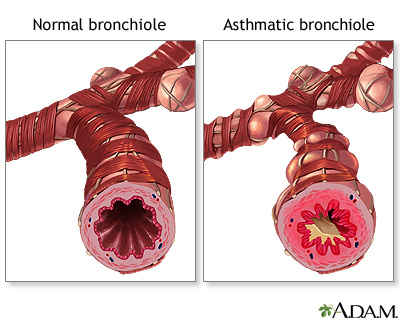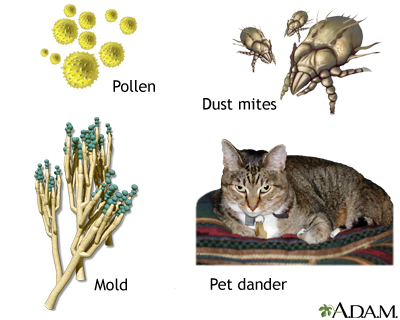Section Title
Asthma
Definition
Asthma is a disease that causes the airways of the lungs to swell and narrow. It leads to wheezing, shortness of breath, chest tightness, and coughing.

Alternative Names
Bronchial asthma; Wheezing - asthma - adults
Causes
Asthma is caused by swelling (inflammation) in the airways. When an asthma attack occurs, the lining of the air passages swells and the muscles surrounding the airways become tight. This reduces the amount of air that can pass through the airway.
In people who have sensitive airways, asthma symptoms can be triggered by breathing in substances called allergens or triggers.

Common asthma triggers include:
- Animals (pet hair or dander)
- Dust mites
- Certain medicines (aspirin and other NSAIDS)
- Changes in weather (most often cold weather)
- Chemicals in the air or in food
- Exercise
- Mold
- Pollen
- Respiratory infections, such as the common cold
- Strong emotions (stress)
- Tobacco smoke
Substances in some workplaces can also trigger asthma symptoms, leading to occupational asthma. The most common triggers are wood dust, grain dust, animal dander, fungi, or chemicals.
Many people with asthma have a personal or family history of
, such as hay fever () or . Others have no history of allergies.Symptoms
Most people with asthma have attacks separated by symptom-free periods. Some people have long-term shortness of breath with episodes of increased shortness of breath. Either wheezing or a cough may be the main symptom.
Asthma attacks can last for minutes to days. Attacks can become dangerous if airflow is severely blocked.
Symptoms of asthma include:
- Cough with or without sputum (phlegm) production
- Pulling in of the skin between the ribs when breathing (intercostal retractions)
- Shortness of breath that gets worse with exercise or activity
- Wheezing
Emergency symptoms that need prompt medical help include:
- Bluish color to the lips and face
- Decreased level of alertness, such as severe drowsiness or confusion, during an asthma attack
- Extreme difficulty breathing
- Rapid pulse
- Severe anxiety due to shortness of breath
- Sweating
Other symptoms that may occur:
- Abnormal breathing pattern -- breathing out takes more than twice as long as breathing in
- Breathing temporarily stops
- Chest pain
- Tightness in the chest
Exams and Tests
The health care provider will use a stethoscope to listen to your lungs. Wheezing or other asthma-related sounds may be heard.
Tests that may be ordered include:
- Allergy testing -- or a to see if a person with asthma is allergic to certain substances
- Arterial blood gas (usually only done with people who are having a severe asthma attack)
- Chest x-ray
- Lung function tests, including peak flow measurements
Treatment
The goals of treatment are:
- Control airway swelling
- Stay away from substances that trigger your symptoms
- Help you to be able to do normal activities without asthma symptoms
You and your doctor should work as a team to manage your asthma. Follow your doctor's instructions on taking medicines, eliminating asthma triggers, and monitoring symptoms.
MEDICINES FOR ASTHMA
There are two kinds of medicines for treating asthma:
- Control medicines to help prevent attacks
- Quick-relief (rescue) medicines for use during attacks
These are also called maintenance or control medicines. They are used to prevent symptoms in people with moderate to severe asthma. You must take them every day for them to work. Take them even when you feel OK.
Some long-term medicines are breathed in (inhaled), such as steroids and long-acting beta-agonists. Others are taken by mouth (orally). Your doctor will prescribe the right medicine for you.
These are also called rescue medicines. They are taken:
- For coughing, wheezing, trouble breathing, or an asthma attack
- Just before exercising to help prevent asthma symptoms caused by exercise
Tell your doctor if you are using quick-relief medicines twice a week or more. If so, your asthma may not be under control and your doctor may need to change your dose of daily control drugs.
Quick-relief medicines include:
- Short-acting inhaled bronchodilators
- Oral corticosteroids for when you have an asthma attack that is not going away
A severe asthma attack requires a checkup by a doctor. You may also need a hospital stay. There, you will likely be given oxygen, breathing assistance, and medicines given through a vein (IV).
ASTHMA CARE AT HOME
- Know the asthma symptoms to watch for.
- Know how to take your peak flow reading and what it means.
- Know which triggers make your asthma worse and what to do when this happens.
- Know how to care for your asthma when you exercise.
Asthma action plans are written documents for managing asthma. An asthma action plan should include:
- Instructions for taking asthma medicines when your condition is stable
- A list of asthma triggers and how to avoid them
- How to recognize when your asthma is getting worse, and when to call your provider
A peak flow meter is a simple device to measure how quickly you can move air out of your lungs.
- It can help you see if an attack is coming, sometimes even before symptoms appear. Peak flow measurements help let you know when you need to take medicine or other action.
- Peak flow values of 50% to 80% of your best results are a sign of a moderate asthma attack. Numbers below 50% are a sign of a severe attack.
Outlook (Prognosis)
There is no cure for asthma, although symptoms sometimes improve over time. With proper self-management and medical treatment, most people with asthma can lead a normal life.
Possible Complications
The complications of asthma can be severe, and may include:
- Death
- Decreased ability to exercise and take part in other activities
- Lack of sleep due to nighttime symptoms
- Permanent changes in the function of the lungs
- Persistent cough
- Trouble breathing that requires breathing assistance (ventilator)
Prevention
You can reduce asthma symptoms by avoiding triggers and substances that irritate the airways.
- Cover bedding with allergy-proof casings to reduce exposure to dust mites.
- Remove carpets from bedrooms and vacuum regularly.
- Use only unscented detergents and cleaning materials in the home.
- Keep humidity levels low and fix leaks to reduce the growth of organisms such as mold.
- Keep the house clean and keep food in containers and out of bedrooms. This helps reduce the possibility of cockroaches. Body parts and droppings from cockroaches can trigger asthma attacks in some people.
- If someone is allergic to an animal that cannot be removed from the home, the animal should be kept out of the bedroom. Place filtering material over the heating outlets to trap animal dander. Change the filter in furnaces and air conditioners often.
- Eliminate tobacco smoke from the home. This is the single most important thing a family can do to help someone with asthma. Smoking outside the house is not enough. Family members and visitors who smoke outside carry smoke residue inside on their clothes and hair. This can trigger asthma symptoms. If you smoke, now is a good time to quit.
- Avoid air pollution, industrial dust, and irritating fumes as much as possible.
References
Cydulka RK, Bates CG. Asthma. In: Adams JG, ed. Emergency Medicine. 2nd ed. Philadelphia, PA: Elsevier Saunders; 2013:chap 48.
Durrani SR, Busse WW. Management of asthma in adolescents and adults. In: Adkinson NF, Bochner BS, Burks AW, et al, eds. Middleton's Allergy Principles and Practice. 8th ed. Philadelphia, PA: Elsevier Saunders; 2014:chap 55.
Lugogo N, Que LG, Gilstrap DL, Kraft M. Asthma: clinical diagnosis and management. In: Broaddus VC, Mason RJ, Ernst JD, et al, eds. Murray and Nadel's Textbook of Respiratory Medicine. 6th ed. Philadelphia, PA: Elsevier Saunders; 2016:chap 42.
National Asthma Education and Prevention Program Expert Panel Report 3: Guidelines for the Diagnosis and Management of Asthma. Rockville, MD. National Heart, Lung, and Blood Institute, US Dept of Health and Human Services; 2007. NIH publication 08-4051. Updated 2012. www.nhlbi.nih.gov/files/docs/guidelines/asthgdln.pdf and www.nhlbi.nih.gov/files/docs/guidelines/asthgdln.doc. Accessed April 29, 2015.
Version Info
- Last reviewed on 4/21/2015
- Neil K. Kaneshiro, MD, MHA, Clinical Assistant Professor of Pediatrics, University of Washington School of Medicine, Seattle, WA. Internal review and update on 07/24/2016 by David Zieve, MD, MHA, Isla Ogilvie, PhD, and the A.D.A.M. Editorial team.
A.D.A.M., Inc. is accredited by URAC, also known as the American Accreditation HealthCare Commission (www.urac.org). URAC's accreditation program is an independent audit to verify that A.D.A.M. follows rigorous standards of quality and accountability. A.D.A.M. is among the first to achieve this important distinction for online health information and services. Learn more about A.D.A.M.'s editorial policy, editorial process and privacy policy. A.D.A.M. is also a founding member of Hi-Ethics and subscribes to the principles of the Health on the Net Foundation (www.hon.ch)
The information provided herein should not be used during any medical emergency or for the diagnosis or treatment of any medical condition. A licensed medical professional should be consulted for diagnosis and treatment of any and all medical conditions. Call 911 for all medical emergencies. Links to other sites are provided for information only -- they do not constitute endorsements of those other sites. © 1997- 2013 A.D.A.M., Inc. Any duplication or distribution of the information contained herein is strictly prohibited.

